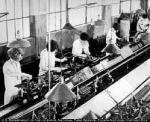Do you sometimes worry about Australia becoming a place that doesn’t “make things” any more? Let me lighten your load. Kevin Rudd used to worry about such things. In his first press conference as opposition leader in 2006, Rudd stressed he wanted to be the prime minister of “a country that actually makes things”.
Today a high dollar is putting extra pressure on manufacturers while also making it cheaper for us to import things that other countries have made.
It is undoubtedly true that only a small proportion of us are engaged in making “things”. Just 8 per cent of working Australians are employed in manufacturing, down from 26 per cent in 1966. Meanwhile, the proportion working in the services sector has risen from 54 per cent to 77 per cent.
More broadly, the proportion of employees working in what the Bureau of Statistics classes “production industries”, including agriculture, forestry, mining, manufacturing, electricity, gas and construction, has halved from 46 per cent to 23 per cent.
In between we’ve largely outsourced the making of things to nimble hands abroad who will do it for less. Is that such a bad thing?
An increasingly globalised economy has not only given Australian consumers access to cheaper products, but to a wider variety of goods for purchase – Japanese cars, Korean TVs, Belgian chocolates, you name it.
The benefits to consumers of increasing trade and specialisation are often overlooked. Millions of consumers have less in common and less cause to rally than smaller groups of people employed in declining industries.
It is understandable and entirely predictable that manufacturers and the people they employ should lobby hard to save their jobs. And they have powerful representatives in unions and Federal Parliament to make their case.
But perhaps part of the reason we’re not making things as much is that we’re not buying things as much. Retail spending here is growing at its slowest annual pace in decades. National accounts figures show annual spending on recreation and culture is up 7 per cent and spending on hotels, cafes and restaurants up 6 per cent. We’re spending more on experiences and less on stuff.
Why? Partly it’s a symptom of our success. Recreation and household services are what economists call “normal goods”; that is, we tend to buy more of them when incomes rise and they come to make up a higher proportion of our total spending. Overseas holidays are normal goods, while bus tickets are “inferior goods”; we tend to buy them less when incomes rise.
The growing role of women in the workforce, while initially boosting demand for manufactured, labour-saving devices such as fridges and washing machines, has also boosted demand for domestic service employees, such as cleaners and childcare workers. These jobs are not so easily sent offshore.
When the Bureau of Statistics began conducting household surveys about people’s employment in the 1960s, the most commonly reported occupation sector was “tradesman, production process workers and labourers”. Today, it’s “professionals”. Now, more than ever, Australians make a living from the agility of our minds rather than the nimbleness of our bodies.
If you want to worry about the future of jobs growth, spend less time worrying about protecting declining industries and more time worrying about the fact that Australian government spending on higher education as a proportion of gross domestic product is one of the lowest of all member countries of the Organisation for Economic Co-operation and Development.
THE IRVINE INDEX
26%
Manufacturing’s share of total employment in 1966.
8%
Manufacturing’s share of
employment today*. *Today means August, 2011.
23%
Percentage of employed people working in production industries today.
12%
Percentage of Australian jobs in the healthcare and social assistance industry the biggest employer nationwide.
54%
Percentage of employed people working in the service sector in 1966.
2% Percentage of Australian jobs accounted for by mining. Agriculture only slightly ahead on 3 per cent.
77%
Percentage of employed people working in the service sector today.
46%
Percentage of employed people working in ‘‘production industries’’ in 1966, including agriculture, forestry, mining and manufacturing.
77%
Increase in the number of people working in the childcare industry over the past decade.
Sources: Bureau of Statistics Australian Labour Market Statistics, October 2011 Feature Article “Fifty Years of Labour Force: Now and then”; Reserve Bank speech by Philip Lowe September, 22 “Changing Patterns in Household Saving and Spending”.


